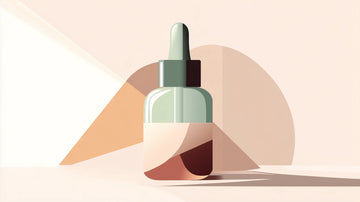Mature skin, often marked by dehydration, loss of elasticity, and signs of aging, requires tailored solutions. Three key ingredients stand out to meet these needs: shea butter, retinol, and hyaluronic acid. Here’s a quick summary of their benefits:
- Shea butter: Deeply hydrates, nourishes, and protects, ideal for dry and sensitive skin.
- Retinol: Encourages cell renewal and improves firmness, though it might feel a bit irritating.
- Hyaluronic acid: Hydrates deeply and quickly, making it perfect for keeping moisture locked in your skin.
Quick Comparison
| Criterion | Shea Butter | Retinol | Hyaluronic Acid |
|---|---|---|---|
| Hydration | Nutrition and protection | Indirectly through regeneration | It retains water effectively |
| Tolerance | Very well tolerated | May irritate | Suitable for all skin types |
| Nourished and soothed skin | Wrinkle Reduction | Immediate hydration |
For an optimal routine: in the morning, apply shea butter and hyaluronic acid, and gradually introduce retinol in the evening. These ingredients can be combined to cater to the specific needs of mature skin.
Shea Butter, Explained
1. Shea Butter
Shea butter is well-known for its ability to deeply hydrate and nourish the skin, making it a precious ally for mature skin. Thanks to its content of fatty acids, it helps to maintain hydration and combat the dryness that’s often associated with aging skin.
Research indicates that regular use improves skin hydration while restoring its suppleness and radiance. Its texture allows it to be used in various ways:
- Daytime Care: Protects your skin from external aggressions.
- Night Mask: Promotes deeper repair.
- Eye contour care: Perfect for sensitive areas.
To fully enjoy its benefits, it's best to use pure, unrefined shea butter. Apply it in the morning to shield your skin, in the evening as a restorative mask, or gently around your eyes to soften this delicate area. Using it every day, both morning and night, can enhance firmness and hydration while being kind to sensitive skin.
By incorporating shea butter into your routine, you can compare its effects to those of other ingredients like retinol or hyaluronic acid, all while exploring other solutions that suit your skin.
2. Retinol
Retinol is often highly valued for its effects on skin aging. Unlike shea butter, which provides immediate hydration, retinol works deep down to stimulate cell renewal.
For mature skin, it can offer some truly notable benefits:
| Aspect | Effects on the skin | Usage Tips |
|---|---|---|
| Hydration | Helps retain water thanks to cellular activity | Start with a low concentration (0.25%). |
| Elasticity | Promotes collagen production | Apply in the evening for the best results |
| Texture | Smooth out the surface and refine your skin texture. | Apply on clean, dry skin |
| Protection | Boost your cellular renewal for a more radiant complexion. | Avoid direct sun exposure after application. |
To avoid irritation, introduce retinol gradually. Start by applying it once or twice a week, then increase the frequency based on your skin's tolerance. Use it in the evening and complement it with a sunscreen in the morning to protect your skin.
If you notice any signs of irritation, try reducing the frequency or opting for gentler products. You can also combine retinol with shea butter, but it's best to apply them at different times throughout the day to help minimize the risk of irritation.
3. Hyaluronic Acid
Hyaluronic acid, naturally present in the skin, decreases as we age. For mature skin, using it offers unique benefits that are different from those of shea butter.
| Feature | Hyaluronic Acid | Comparison with Shea Butter |
|---|---|---|
| Type of hydration | Deeply hydrate by locking in moisture | Moisturizes by nourishing and protecting |
| Absorption | Penetrates quickly, without leaving a greasy film. | Create a protective barrier |
| Compatibility | Suitable for all skin types, even sensitive ones | Great for very dry skin |
| Duration of action | Immediate effect, just remember to reapply regularly! | Enjoy long-lasting results, thanks to its rich texture. |
These elements underscore the importance of a well-thought-out formulation to fully benefit from hyaluronic acid.
For maximum effectiveness, opt for formulas that contain various molecular weights:
- Low molecular weight (< 50 kDa): penetrates deeply for intense hydration.
- High molecular weight (> 1000 kDa): stays on the surface to provide immediate hydration.
Hyaluronic acid and shea butter can also be used together. First, apply the hyaluronic acid on slightly damp skin, followed by the shea butter to seal in the hydration. This combination meets the needs of mature skin for both moisture and lipids.
Unlike shea butter, which can be used on its own, hyaluronic acid requires a specific formulation to ensure its stability and effectiveness. Opt for products containing a concentration of hyaluronic acid between 1% and 2% to achieve optimal results while avoiding potential irritations.
Direct Comparison Results
Here is a comparative analysis of the three ingredients:
| Criterion | Shea Butter | Retinol | Hyaluronic Acid |
|---|---|---|---|
| Main effect | Nourishes, protects, and soothes the skin | Boost cell renewal | Moisturize immediately for lasting hydration |
| How It Works | Provides progressive nutrition | Requires regular use | Works quickly by retaining water. |
| Possible reactions | Well tolerated even with frequent use | May cause irritation if misused | Compatible with sensitive skin |
This information lets you adjust the use of each ingredient based on the needs of mature skin:
- Shea butter is ideal for everyday use thanks to its nourishing properties.
- The hyaluronic acid works quickly for immediate hydration.
- While retinol is powerful, it should be used with care, especially for sensitive skin.
Practical recommendations:
- In the morning: combine shea butter and hyaluronic acid for optimal hydration.
- In the evening: gradually introduce retinol to stimulate cell regeneration while minimizing irritation.
This analysis shows that by adjusting how these ingredients are used, it's possible to meet the specific needs of mature skin while respecting its sensitivity. We'll dive deeper into these aspects in the 'Key Findings' section.
Key Points
Shea butter is a valuable ally for nourishing and protecting mature skin. Here are our recommendations based on a detailed analysis:
| Skin type | Recommended solution | Usage Frequency |
|---|---|---|
| Very dry | Pure shea butter | Twice a day |
| Mixed and Mature | Shea butter + Hyaluronic acid | Only in the morning |
| Sensitive | Shea butter (light formula) | Evening only |
These suggestions show clear benefits for the skin’s texture and glow. Shea butter stands out for its ability to be easily absorbed, its natural protective properties, and its versatility in anti-aging care.
Adjust your usage according to the season:
- Winter: apply a generous layer in the evening.
- Summer: opt for a lightweight texture in the morning.
For optimal results, pair it with hyaluronic acid. This combination delivers deep nourishment and immediate hydration, perfect for addressing the unique needs of mature skin while being gentle on its sensitivity.






